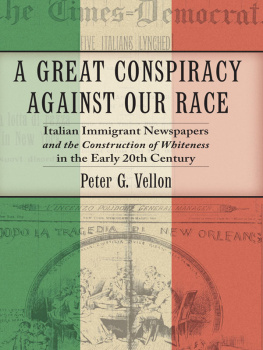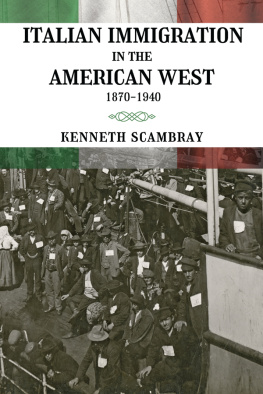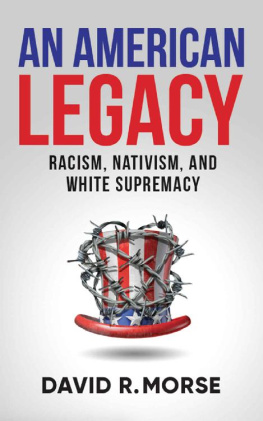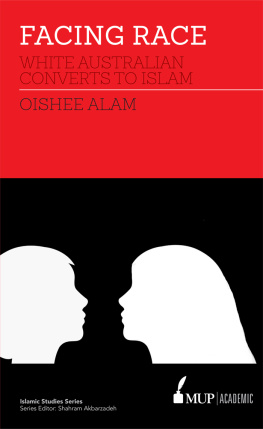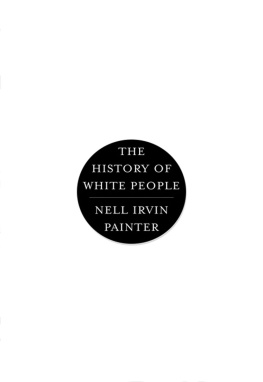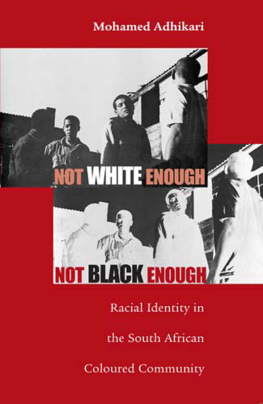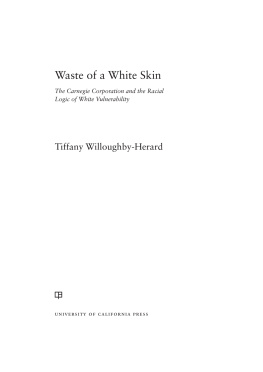
A GREAT CONSPIRACY AGAINST OUR RACE
CULTURE, LABOR, HISTORY SERIES
General Editors: Daniel Bender and Kimberley L. Phillips
The Forests Gave Way before Them:
The Impact of African Workers on the
Anglo-American World, 16501850
Frederick C. Knight
Unknown Class: Undercover Investigations
of American Work and Poverty from
the Progressive Era to the Present
Mark Pittenger
Steel Barrio: The Great Mexican
Migration to South Chicago, 19151940
Michael D. Innis-Jimnez
Ordering Coal: Railroads, Miners, and
Disorder in the Gilded Age, 18701900
Andrew B. Arnold
A Great Conspiracy against Our Race: Italian
Immigrant Newspapers and the Construction
of Whiteness in the Early Twentieth Century
Peter G. Vellon
A Great Conspiracy against Our Race
Italian Immigrant Newspapers and the Construction of Whiteness in the Early Twentieth Century
Peter G. Vellon

NEW YORK UNIVERSITY PRESS
New York and London
www.nyupress.org
2014 by New York University
All rights reserved
References to Internet websites (URLs) were accurate at the time of writing.
Neither the author nor New York University Press is responsible for URLs that may have expired or changed since the manuscript was prepared.
LIBRARY OF CONGRESS CATALOGING-IN-PUBLICATION DATA
Vellon, Peter G.
A great conspiracy against our race : Italian immigrant newspapers and the construction of whiteness in the early twentieth century / Peter G. Vellon.
pages cm (Culture, labor, history Series)
Includes bibliographical references and index.
ISBN 978-0-8147-8848-6 (cloth : alkaline paper)
1. Italian American newspapersHistory20th century. 2. Italian AmericansRace identityHistory20th century. 3. WhitesUnited StatesRace identityHistory20th century. 4. ImmigrantsUnited StatesHistory20th century. 5. Italian AmericansCultural assimilationHistory20th century. 6. Italian AmericansSocial conditions20th century. 7. United StatesRace relationsHistory20th century. I. Title.
PN4885.I8V45 2014
071.308951dc23
2014016413
New York University Press books are printed on acid-free paper, and their binding materials are chosen for strength and durability.
We strive to use environmentally responsible suppliers and materials to the greatest extent possible in publishing our books.
Manufactured in the United States of America
10 9 8 7 6 5 4 3 2 1
Also available as an ebook
CONTENTS
ACKNOWLEDGMENTS
In 1997, I had the good fortune of meeting Philip V. Cannistraro at the Graduate Center at The City University of New York. One of the leading scholars in Italian American history, Phil took an immediate interest in my work on ethnicity and race. Although Phil passed away much too soon in 2005, it is not an understatement to say this book could have never been published without him. He consistently provided keen advice, insightful comments, and much-needed encouragement. His generosity as a scholar and mentor continue to inspire me to provide the same guidance for my students. I am eternally grateful to have called him my friend.
I am also indebted to Carol Berkin, who has bravely served as my unofficial adviser and sage after Phils passing. Simply put, Carol has always been there when I needed her. Whether she was reading chapters of the manuscript, offering her expertise in the realm of academia, or lending an ear to my neurotic ramblings, Carols kindness is truly extraordinary. There are many others who have made this book a reality. I owe a great debt to David Roediger, whose own work has inspired the way I interpret and read history. In 2006, he reassured me that a book centered on the Italian language press and race would be not only worthwhile but a welcome addition to the literature. At a very delicate time in my life, his confidence in the project proved vital to my going forward. Heartfelt thanks go to Mary Anne Trasciatti and the late Nunzio Pernicone, who both read through the manuscript during its early stages, offering invaluable advice. A host of other scholars have read specific chapters, provided insightful comments, and offered pointed critiques or suggestions about sources or methodology. The book is much better due to their generosity. Special thanks go to Fred Gardaphe, Michael Topp, Donna Gabaccia, Anthony Tamburri, Thomas Guglielmo, the late Rudolph Vecoli, Peter Carravetta, Stanislao Pugliese, and Bill Connell.
Many more people and institutions made this book possible. I am deeply indebted to New York University Press, especially Kim Phillips, Dan Bender, and former editor Deborah Gershenowitz for believing in this project. I would also like to thank current editor Clara Platter and editorial assistant Constance Grady for their hard work, assistance, and patience. I am very grateful for the funding and support I have received throughout this process. Awards such as the E. P. Thompson Fellowship and Mario Capelloni Fellowship from the Graduate Center/CUNY, along with grants from the National Italian American Foundation, helped me complete the initial stages of my research. Grants from the Professional Staff Congress/CUNY in the form of a PSC-CUNY Research Award, as well as being selected to participate in the CUNY Faculty Fellowship Publication Program, proved immeasurable in shaping the book into its current form. Thanks to my fellow FFPP members for their comments, especially Virginia Sanchez-Korrol, Kathy Lopez, and Cindy Lobel. I also would like to thank the staff at the Immigration Research History Center at the University of Minnesota, especially Sara Wakefield, for their assistance during my visit. Additionally, thanks to the staff at the New York Public Library and the Schomburg Center for Research in Black Culture for their patience while I spent months immersed in microfilmed Italian language newspapers. Many thanks to the archivists at Tulane University and the University of New Orleans, as well as the staff at the Archivio Storico del Ministero degli Affari Esteri in Rome, Italy.
Special thanks are also extended to the many friends and family members who were instrumental in pushing me along during the wearisome process of writing and researching. My Graduate Center posse and dear friends Cindy Lobel, Delia Mellis, Erica Ball, Kathy Feeley, and Terence Kissack offered plenty of advice, suggestions, and comedic interludes during the process. I am so appreciative for having met them. I thank David Aliano for his friendship and support, as well as some helpful translations. Thanks to Jeffrey Trask, who opened his apartment to our writing group; the time spent there proved instrumental in completing two chapters. I have also benefited from the support of colleagues and friends in the History Department at Queens College/CUNY, especially Joel Allen, Sarah Covington, Premilla Nadasen, and Frank Warren. Many thanks to Augusto Pasquariello, who tirelessly translated hundreds of Italian language newspaper articles without complaint. Thanks also to Nella Giusto, who spent her vacation in New York City helping with translations as well. Sometimes you meet special people along the way, often for brief periods, who influence the trajectory of your future. One such person is Richard DiMedia. I thank him for his inspiration in the classroom and his belief that I could pursue and earn a PhD in history. Hratch and Leslie Zadoian are two people who have remained influential in my life and whose friendship I treasure. Hratch continues to be an endless source of knowledge, wisdom, and humor. I am a better person for knowing him.
Next page
